In the dynamic arena of today’s digital world, businesses are on a continuous quest to elevate their online footprint and enrich their customer shopping experiences. At the forefront of this eCommerce revolution is the cutting-edge technology known as headless commerce. As we delve into 2023, understanding the latest headless commerce statistics is crucial for businesses aiming to stay ahead in the competitive eCommerce arena.
Grasping these pivotal headless commerce stats empowers businesses to make strategic decisions, leveraging this robust tool to maintain a competitive edge in a market that’s ever-evolving and increasingly focused on the customer.
Table of Contents
- Market Overview of Headless Commerce
- Headless Commerce Usage in the World
- Businesses’ Headless Commerce Implementation
- Rapid Integration of Headless Commerce in Existing Infrastructure
- Global Adoption Trends: A Steady Rise in Headless Commerce Usage
- The Future Projection: Moving from Monolithic to Headless Platforms
- B2C Brands Rallying Toward Headless Commerce
- The Surge of Headless Commerce in B2B: A Strategic Shift on the Horizon
- The Pivotal Role of Headless Commerce in B2B
- Retailers Embracing Headless Commerce for Technology Modernization
- Headless Commerce: A Beacon for Startups and SMEs
- SMEs at the Forefront of the Headless Commerce Revolution
- A Challenge for eCommerce Decision-Makers
- Performance and Efficiency of Headless Commerce
- Impact of Headless Commerce on Businesses
- Future of Headless Commerce Adoption Trend
Market Overview of Headless Commerce
In the current era of digital innovation, the eCommerce sector is undergoing rapid evolution. At the forefront is headless commerce, a technology that’s rapidly gaining ground in online retail. This approach, which decouples the front-end user interface from the back-end eCommerce functionality, provides a level of flexibility and customization previously unattainable in traditional eCommerce platforms.
Projected Market Growth and the Expansion of Headless Commerce
The projected growth trajectory of headless commerce is nothing short of remarkable. With an anticipated Compound Annual Growth Rate (CAGR) of 20.5% through 2027, the market value of headless commerce is expected to reach an impressive $32.1 billion. This figure not only highlights the vast potential of headless commerce but also signifies its increasing influence in the digital retail market.
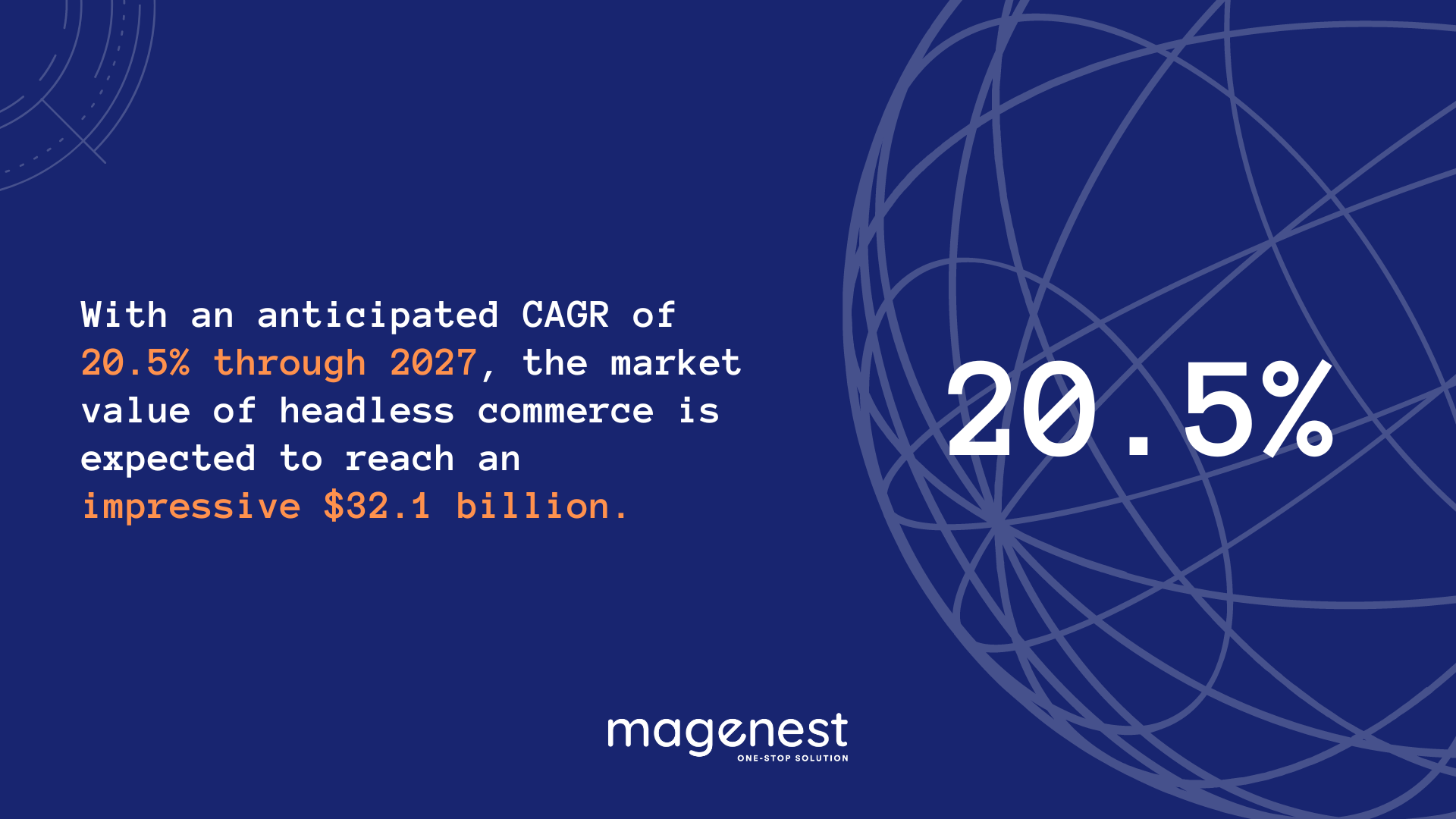
For businesses either considering entering the eCommerce space or those looking to update their current strategies, these numbers are highly significant. They underscore the growing importance and viability of headless commerce in modern digital retail strategies. As the market continues to expand, it becomes increasingly crucial for companies to understand and embrace this agile and innovative approach.
The continuous expansion of headless commerce is a clear indicator of its sustainability and relevance in the ever-evolving digital marketplace. As headless commerce garners a significant share of the market, it’s vital for businesses to stay informed and adaptable, leveraging the technology to remain competitive in a dynamic, customer-centric market.
Investment and Financial Backing for Headless Commerce
The investment landscape for headless commerce further attests to its growing significance. On average, organizations are investing a noteworthy $2.6 million into headless architectures. This level of financial commitment reflects the eagerness of companies to transition to more adaptable digital platforms. The period of 2020–2021 alone saw over $1.65 billion in funding for headless technology, according to Forbes. These figures not only underline the potential of headless commerce but also its rapidly increasing influence in the market.
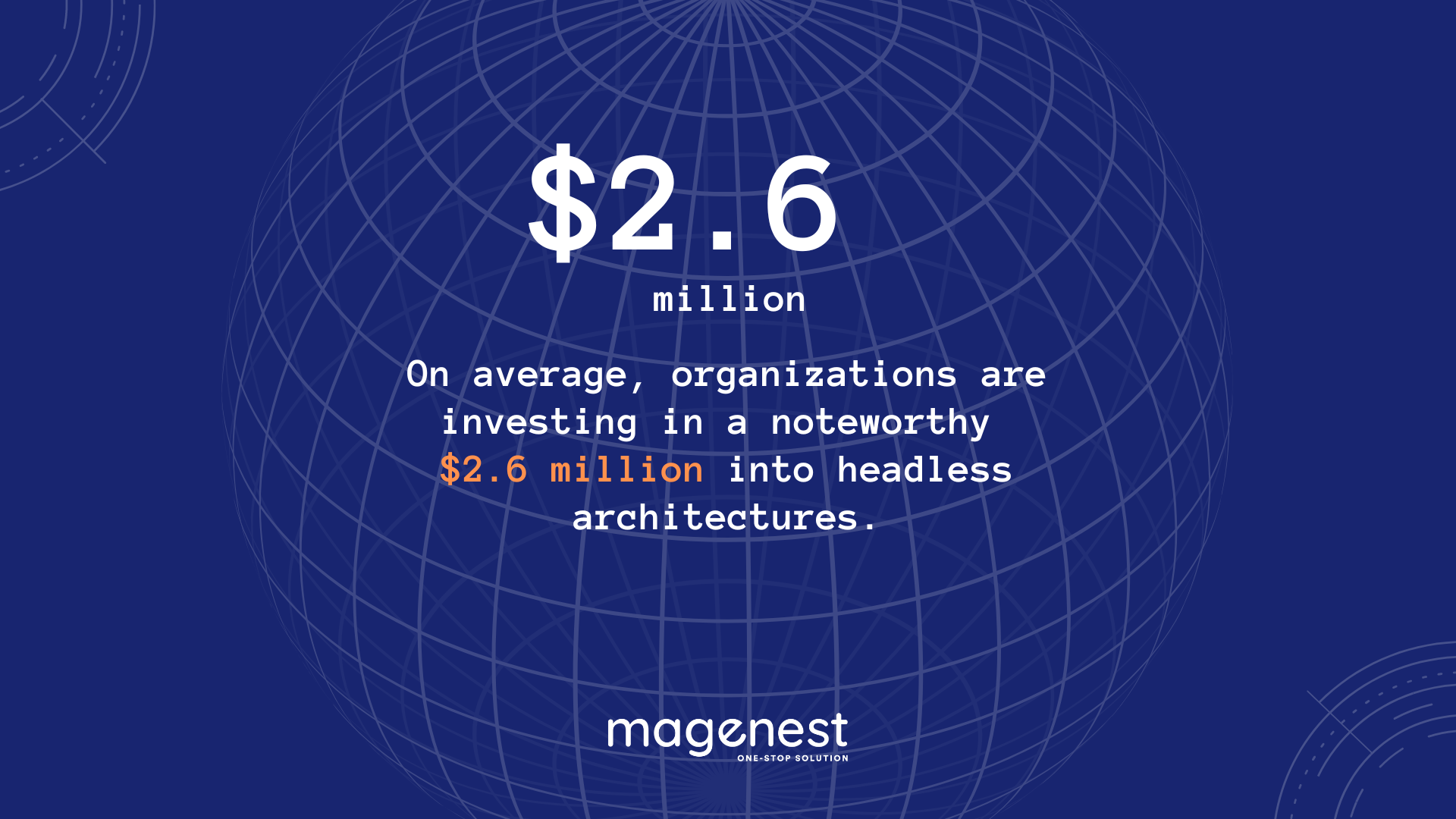
With the substantial investments pouring in, the expectation for a significant return on investment (ROI) from headless commerce solutions is mounting. Companies are not just investing capital, they are also investing their future in this technology, expecting it to yield enhanced efficiency, better customer experiences, and ultimately, higher profitability.
The Dominance of Retail Industry in the Headless Commerce Market
The retail industry is poised to make a substantial impact in the headless commerce market, with projections indicating a dominant 33% market share by 2026. The 33% figure is more than a statistic, it’s a testament to the growing recognition of headless commerce as a game-changer in the retail world. It signifies a shift towards more agile, personalized, and scalable eCommerce solutions, aligning with the dynamic demands of modern consumers.
The prediction of the retail industry dominating a significant portion of the headless commerce market by 2026 sheds light on the potential growth opportunities and the extensive transformation that is on the horizon. Retailers are gearing up to leverage the benefits of headless commerce, including enhanced customer experiences, greater flexibility in front-end design, and the ability to seamlessly integrate with various digital touchpoints. This aligns with the industry’s pursuit of innovation, efficiency, and a deeper engagement with customers.
Headless Commerce Usage in the World
Europe and North America: Pioneers in Headless Commerce
In the dynamic and ever-evolving world of headless commerce, Europe and North America stand out with an impressive 63% combined global market share. This significant statistic not only highlights the adoption rates in these regions but also indicates their pivotal role in driving the headless commerce revolution. The dominance of Europe and North America in the headless commerce landscape is a clear testament to their forward-thinking approach and readiness to embrace innovative digital commerce solutions.
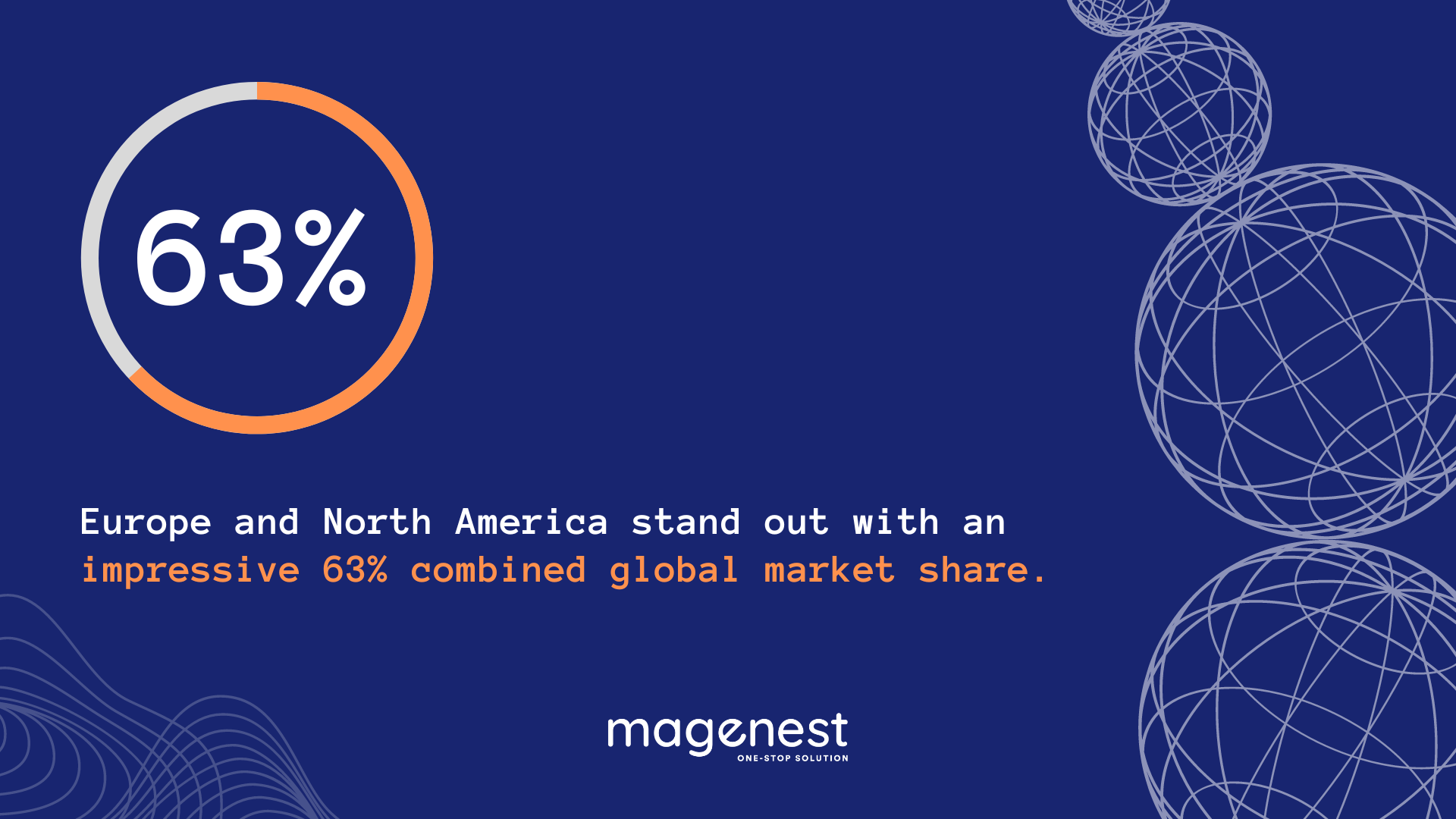
Europe’s contribution to this figure is significant, reflecting the region’s inclination towards advanced technological solutions in digital commerce. European businesses are increasingly recognizing the advantages of headless commerce, such as enhanced customer experience, greater flexibility, and faster go-to-market times. This adoption is being driven by the need to meet the high expectations of digitally savvy European consumers and the desire for businesses to stay competitive in a rapidly changing digital landscape.
North America’s Commanding Presence in Headless Commerce
The North American market, particularly in 2020, accounted for a remarkable 35.2% of the global headless commerce market. This dominance underscores the region’s commitment to innovating and optimizing customer experiences across multiple digital platforms. The adoption of headless commerce in North America can be attributed to its pursuit of agility, scalability, and the ability to quickly adapt to changing consumer behaviors and technological advancements. This significant market share also points to North American companies’ role as trendsetters in the digital commerce arena, paving the way for a more dynamic, customer-focused future.
Businesses’ Headless Commerce Implementation
Rapid Integration of Headless Commerce in Existing Infrastructure
By the end of 2021, an estimated 32% of businesses had already integrated headless commerce into their existing infrastructure. This significant statistic underscores the growing recognition of headless commerce’s potential among businesses. It’s a clear indicator of the technology’s emerging role as a key component in the digital commerce landscape. The increasing adoption rate reflects a strategic shift as businesses aim to enhance their online presence and adapt to evolving consumer behaviors.
Global Adoption Trends: A Steady Rise in Headless Commerce Usage
The trend toward headless commerce is not just limited to specific regions or industries. By 2023, it’s expected that 57% of organizations globally will be using headless commerce platforms. This widespread adoption speaks to the universal appeal and applicability of headless commerce, transcending geographical and sectorial boundaries. It demonstrates a global shift towards more agile, scalable, and customer-focused eCommerce solutions.
The Future Projection: Moving from Monolithic to Headless Platforms
Looking further ahead, by 2025, about 35% of businesses plan to transition from traditional monolithic to headless commerce platforms. This forward-thinking approach indicates a deep understanding of the long-term benefits of headless commerce, such as faster time to market, greater flexibility, and improved customer experiences. The growing popularity of headless platforms signifies a paradigm shift in how businesses approach eCommerce, moving towards more modular, adaptable, and innovative solutions.
B2C Brands Rallying Toward Headless Commerce
The allure of headless commerce has not gone unnoticed in the B2C sector. An impressive 60% of B2C brands are anticipated to adopt this technology by 2022. This surge in adoption rates highlights headless commerce as more than a passing trend; it’s becoming a critical element in digital transformation strategies. B2C brands, known for their customer-centric approaches, are leveraging headless commerce to offer more personalized and engaging customer experiences, recognizing their potential to provide a competitive edge in the fast-paced digital marketplace.
The Surge of Headless Commerce in B2B: A Strategic Shift on the Horizon
A remarkable 50% of B2B businesses surveyed are planning to adopt headless commerce within the next 12 months. This figure not only highlights the rapid pace of digital transformation but also underscores the growing emphasis on delivering exceptional customer experiences in the competitive online sales arena.
This notable shift towards headless commerce among B2B businesses reflects a strategic realignment, recognizing the need for more agile, flexible, and scalable eCommerce solutions. Headless commerce, with its ability to separate the front-end presentation layer from the back-end commerce functionality, offers businesses the versatility to quickly adapt to market trends and customer needs.
The inclination of half of the surveyed B2B businesses to transition to headless commerce within such a short timeframe is a testament to the technology’s perceived value in enhancing customer interaction and operational efficiency. This statistic is a clear indicator of the trajectory of B2B commerce, moving towards more technologically advanced, customer-centric models.
The Pivotal Role of Headless Commerce in B2B
In the realm of B2B commerce, the concept of delivering seamless customer experiences has taken center stage, and headless commerce is at the heart of this transformation. An overwhelming 90% of B2B executives consider headless commerce essential in achieving this goal, a statistic that underscores the strategic importance of this technology in the modern business environment.
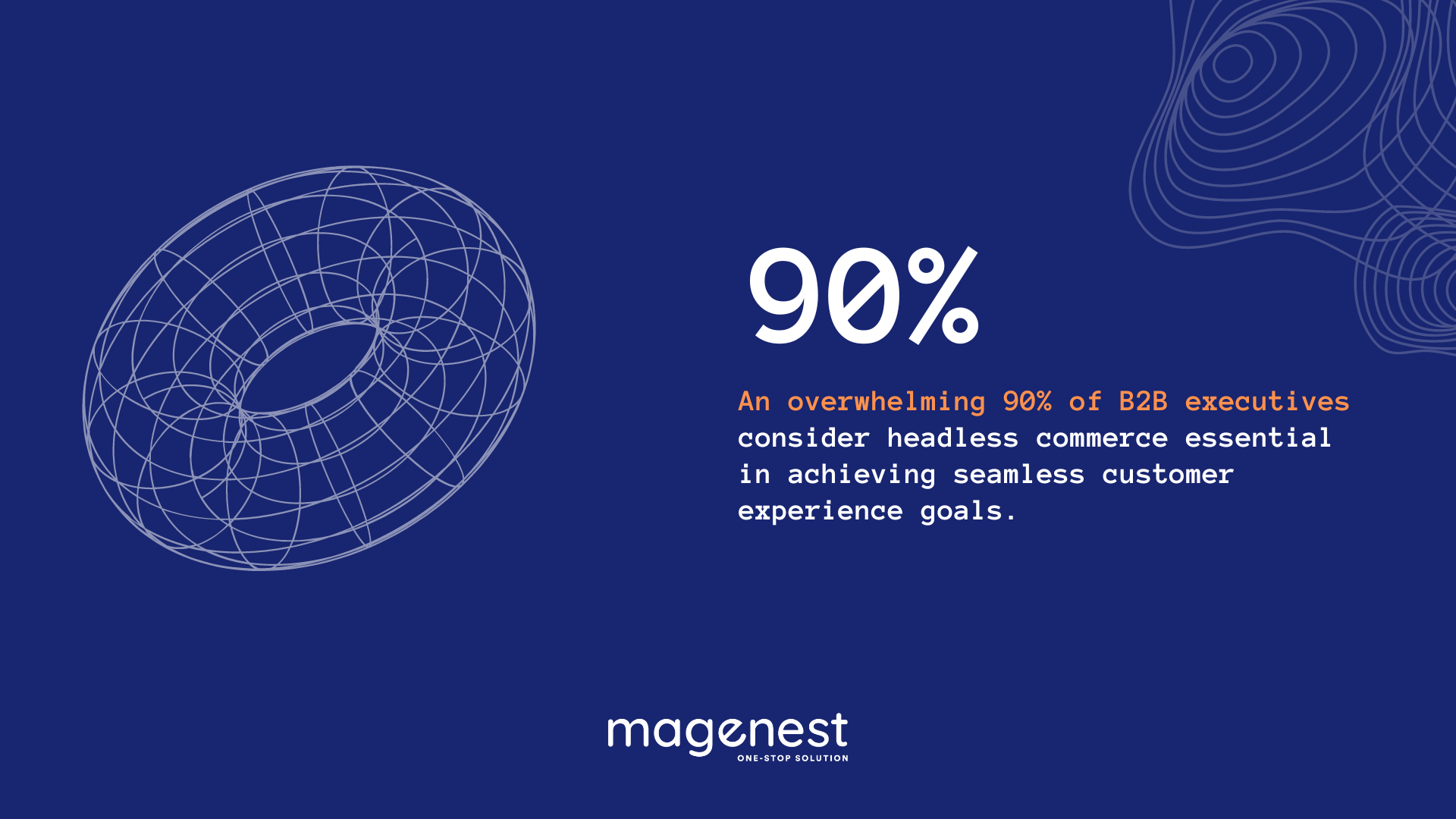
This staggering figure highlights the consensus among B2B leaders regarding the effectiveness and future readiness of headless commerce. As the focus of the headless commerce narrative, it validates the immense value businesses are placing on this approach. This widespread endorsement of headless commerce among executives reflects a profound understanding of its benefits, including flexibility, scalability, and the ability to provide consistent and engaging experiences across various customer interaction points.
The adoption of headless commerce in B2B settings is a response to the growing need for agility and adaptability in digital platforms. Executives are recognizing that traditional commerce systems often fall short in meeting the dynamic needs of today’s market. In contrast, headless commerce offers the versatility to keep pace with evolving customer preferences and technological advancements, enabling businesses to deliver more personalized and efficient customer experiences.
Retailers Embracing Headless Commerce for Technology Modernization
In the rapidly evolving retail landscape, headless commerce has emerged as a key player in the drive toward technological modernization. A notable 44% of retailers surveyed have pinpointed headless commerce solutions as their strategic choice for updating and enhancing their technology stack. This significant percentage sheds light on the mindset prevalent among modern retailers who are keenly aware of the benefits offered by headless commerce.
This statistic is not just a number; it’s a reflection of a broader trend in the retail industry. Retailers are increasingly acknowledging the need for more agile, flexible, and scalable eCommerce solutions to stay competitive. The adoption of headless commerce represents a move away from traditional, monolithic eCommerce platforms towards more dynamic, adaptable systems that can quickly respond to market changes and evolving customer expectations.
Headless Commerce: A Beacon for Startups and SMEs
There’s a striking headless commerce statistic that makes people surprise: 62.5% of its adopters are early-stage startups or small-to-medium enterprises (SMEs). This significant figure highlights the eagerness of smaller, agile businesses to embrace the innovative potential offered by headless commerce solutions.
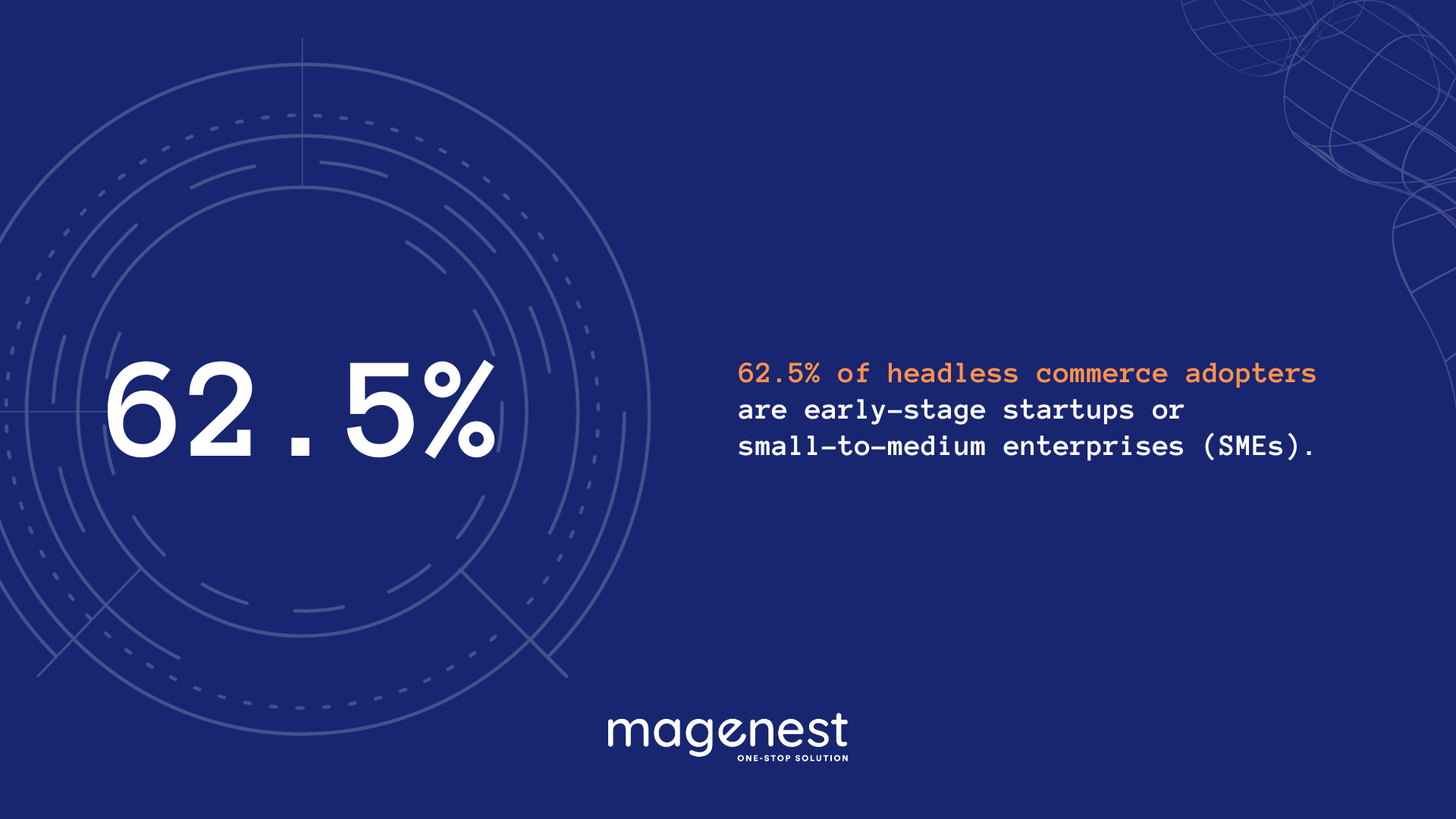
This trend underscores the forward-thinking nature of budding entrepreneurs and SMEs, who are increasingly recognizing the benefits of headless commerce. Unlike traditional eCommerce platforms, headless commerce provides these businesses with the flexibility to tailor customer experiences and rapidly adapt to changing market demands without the constraints of a monolithic architecture.
The statistic reflects a broader shift in the eCommerce industry, where nimble and innovative startups and SMEs are not just following but leading the way in adopting new technologies. These businesses are at the forefront of exploring headless commerce’s potential to disrupt the traditional eCommerce model, offering more personalized and seamless shopping experiences.
SMEs at the Forefront of the Headless Commerce Revolution
Small and Medium Enterprises (SMEs) command a dominant 60% share of the market. This significant statistic sheds light on the pivotal role that SMEs are playing in the widespread adoption and advancement of headless commerce.
This substantial market share held by SMEs underscores their readiness to embrace innovative technologies. By integrating headless commerce solutions, these enterprises demonstrate agility and adaptability, key traits for navigating the rapidly evolving digital eCommerce space. This trend is a reflection of SMEs’ commitment to leveraging cutting-edge technology to offer seamless customer experiences and to establish scalable, future-ready business models.
The success of SMEs in the headless commerce market is not just a statistic; it’s a powerful narrative for the entire business ecosystem. It serves as an inspiration for other businesses, including startups and established companies, to explore the potential of headless commerce. The ability of SMEs to effectively harness this technology highlights its accessibility and adaptability, making it a viable option for businesses of various sizes and sectors.
A Challenge for eCommerce Decision-Makers
Headless commerce stands as a transformative technology. However, a surprising statistic reveals a significant challenge in this domain: only 29% of eCommerce decision-makers fully comprehend what headless commerce is and how it functions. This startling figure indicates a considerable gap in understanding among those at the helm of eCommerce strategy and decision-making.
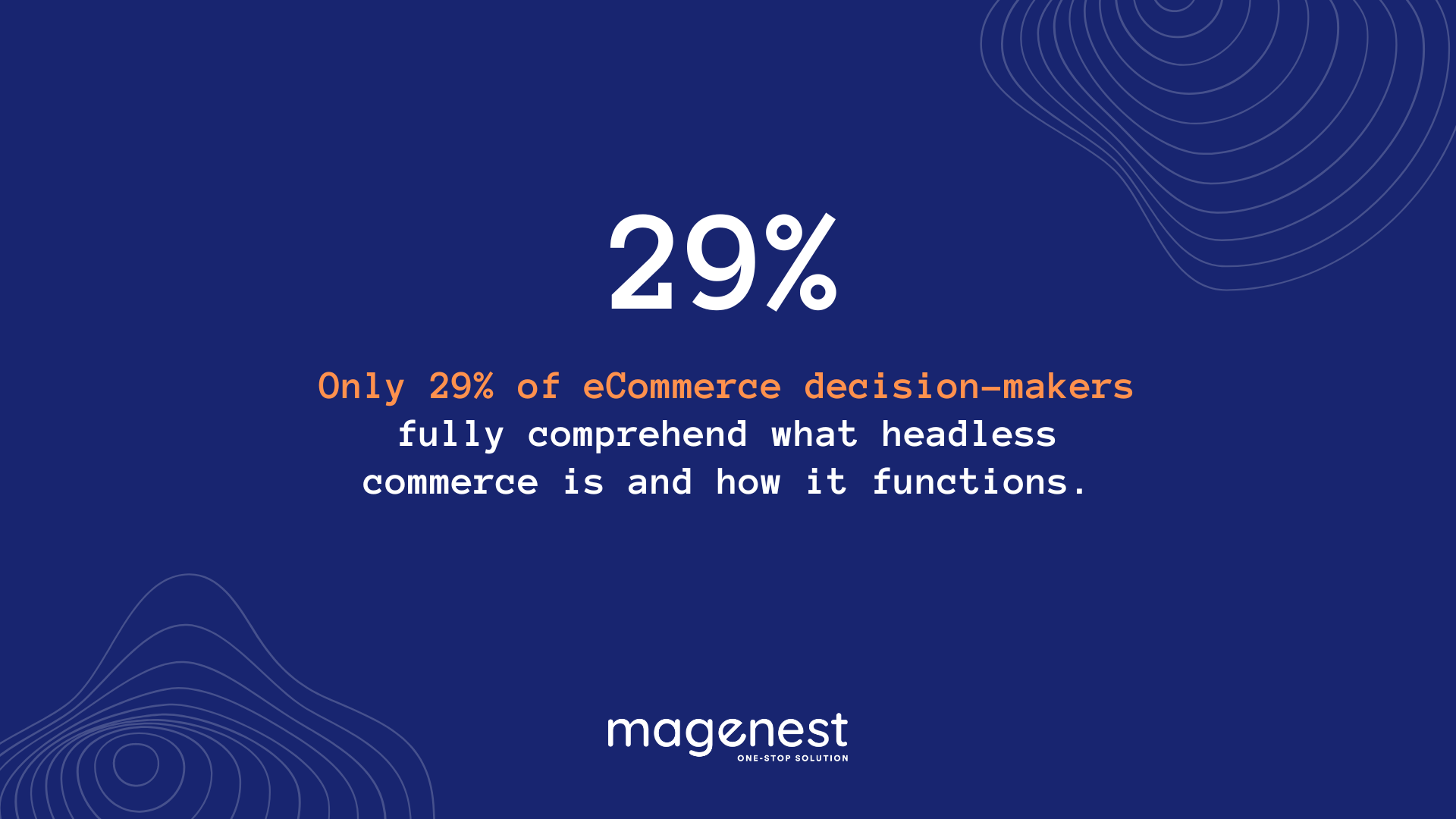
This lack of comprehensive knowledge about headless commerce among the majority of decision-makers is a critical drawback in the industry. It not only hinders the effective implementation of this technology but also slows down the innovation process. The statistic underscores the urgent need for education and clarity in the realm of headless commerce, emphasizing that merely knowing about technology is not the same as understanding its intricacies and potential applications.
The fact that a mere 29% of industry leaders fully understand headless commerce also poses risks for businesses looking to adopt this approach. Without a thorough understanding, decision-makers may not be able to fully leverage the benefits of headless commerce or may misinterpret its capabilities, leading to ineffective strategies and potential setbacks in their digital transformation journey.
Performance and Efficiency of Headless Commerce
Headless Commerce’s 30% Boost Performance Edge
A key statistic highlights the headless commerce impact on the site’s overall performance: adopting headless commerce platforms can lead to a remarkable 30% improvement in site performance. This figure represents a significant advantage for businesses striving to optimize their online presence.
However, it’s important to note that while the potential for performance improvement is significant, realizing these gains requires a strategic approach. Businesses must have the expertise to implement and manage headless commerce solutions effectively. Without proper understanding and execution, the benefits of headless commerce may not be fully realized, and businesses could face challenges in integrating this technology with their existing systems and processes.
The Speed Advantage: Headless Commerce Enhancing User Experience
A standout statistic from the realm of headless commerce reveals that an impressive 90% of users on headless commerce platforms experience faster page load times. This significant figure highlights the efficiency and robustness of headless commerce systems, showcasing their potential to dramatically improve online shopping experiences.
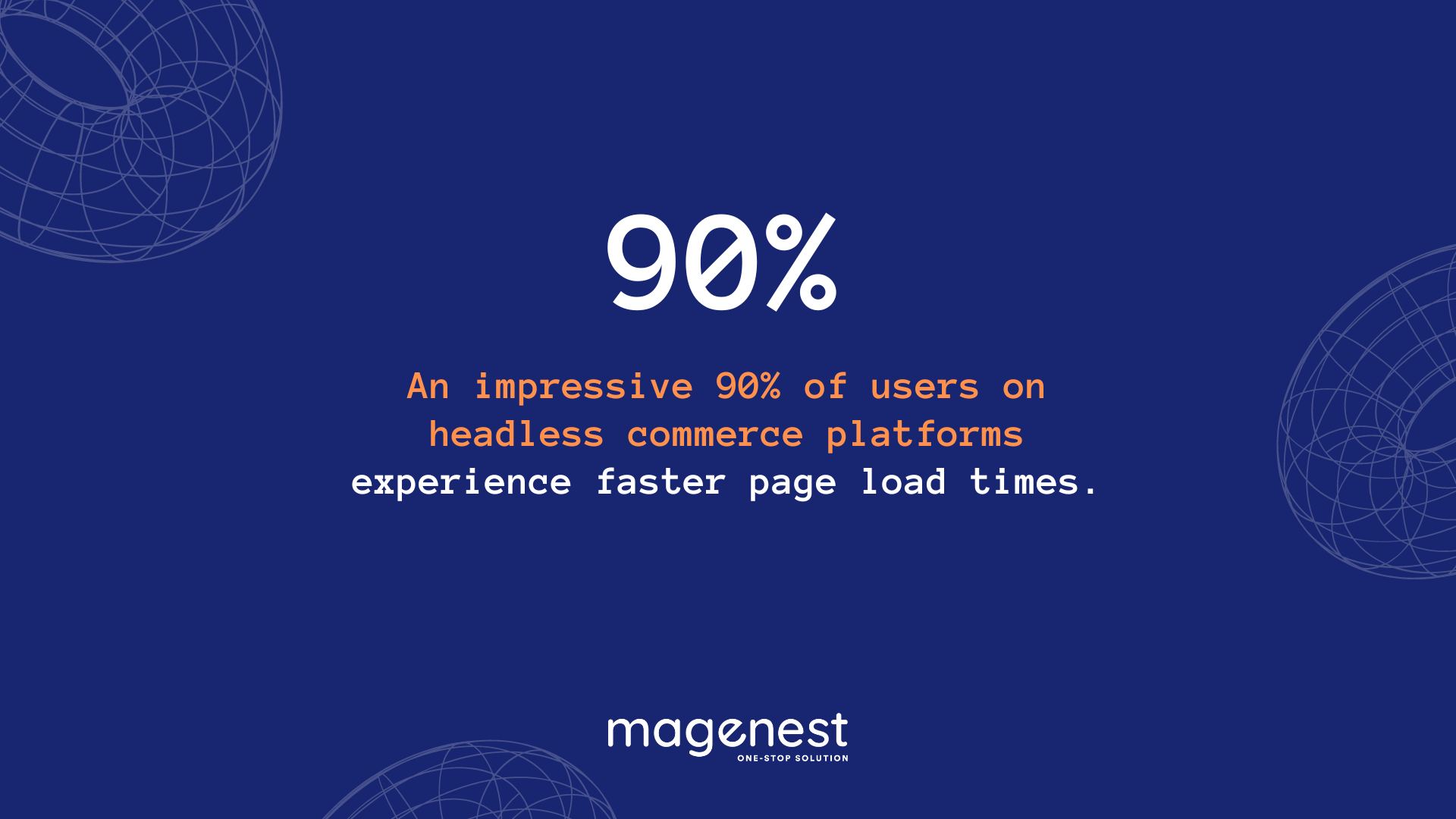
The importance of this statistic cannot be overstated in today’s fast-paced digital marketplace. Faster page load times not only enhance the user experience but also contribute to increased customer satisfaction and improved conversion rates. In an environment where seconds can impact consumer decisions, the speed offered by headless commerce platforms becomes a substantial competitive advantage for brands and businesses.
However, while the improvement in page load times is a notable benefit, it also brings to light the need for businesses to have the necessary technical expertise to implement and manage headless commerce solutions effectively. The complexity of headless architectures can be a challenge for some organizations, particularly those without robust IT resources.
The Transformative Impact of Headless Commerce on Operation
Headless commerce is revolutionizing the way online businesses handle upgrades and bug fixes, delivering unparalleled efficiency. A standout feature of this technology is the remarkable 34% reduction in the time users spend on these critical maintenance activities, emphasizing the agile and streamlined nature of headless commerce.
This significant time-saving benefit is a testament to the core strength of headless commerce: its capacity for rapid, effective implementation of changes and swift problem resolution. Distinct from traditional eCommerce platforms, where updates and fixes often entail lengthy and disruptive processes, headless commerce offers a smoother and more efficient workflow. This efficiency stems from its innovative architecture that separates the front-end and back-end, allowing for independent modifications without crossover disruptions.
The notable 34% reduction in time dedicated to upgrades and bug fixes translates into enhanced operational efficiency for businesses. More importantly, it equips them with the agility to quickly adapt to market shifts and evolving consumer needs. In the dynamic and competitive realm of eCommerce, this ability to swiftly respond and stay ahead is not just beneficial but critical for maintaining market relevance and driving success.
Headless Commerce Enhances the Site Management Efficiency
Headless commerce is proving to be a formidable asset for businesses, evidenced by the fact that 84% of its users report significant enhancements in site management efficiency. This striking statistic highlights the profound effect headless commerce is having on the transformation and optimization of online business operations.
The vast majority of businesses reaping the benefits of headless commerce is indicative of the substantial gains this approach offers. By decoupling front-end design from back-end data functionality, headless commerce allows for more streamlined and efficient site management. This architectural shift enables quicker updates, simpler integration of new features, and a more agile approach to adapting to market changes.
Enhanced Agility in eCommerce with Headless Architecture
One of the significant challenges online stores face is avoiding time-consuming bottlenecks, particularly when updating their digital storefronts. A cumbersome back-end can negatively impact team productivity and, in turn, the overall customer experience.
Headless commerce emerges as a solution to this challenge, drastically reducing the time required for updates and changes. Traditionally, what might have taken days or even weeks can now be accomplished in a matter of hours with headless architecture. This is evidenced by findings from the State of Commerce report, which shows that 77% of organizations using headless architecture have experienced increased agility, enabling them to implement changes to their storefronts more swiftly.
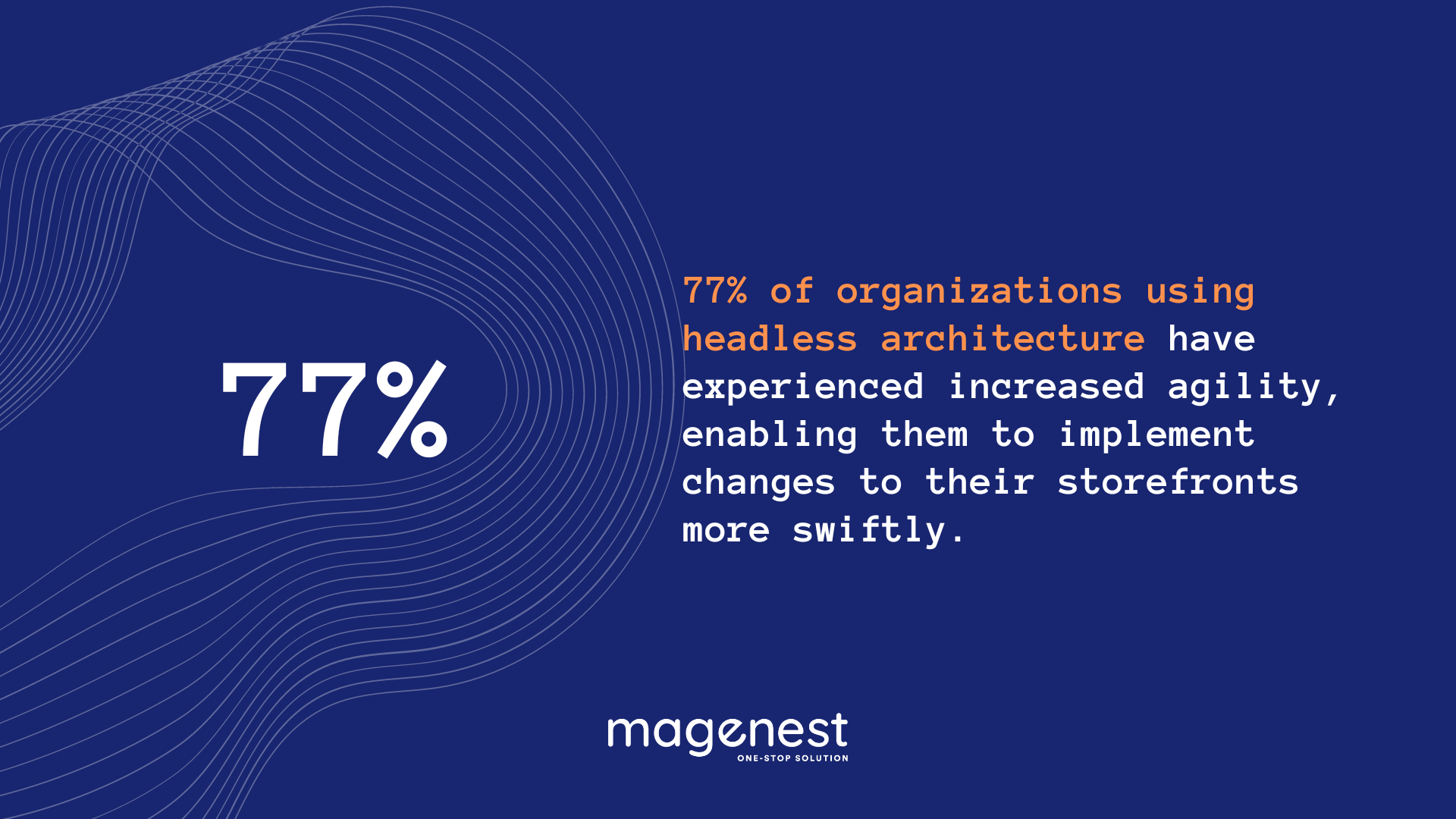
This streamlined approach provided by headless commerce allows businesses to adapt quickly to shifts in consumer behavior and expectations. It’s not just about speed; it’s also about the capability to expand into new channels more efficiently. Organizations utilizing headless commerce architectures report a marked improvement in their ability to venture into new markets and channels, underscoring the strategic advantage of this approach in the dynamic eCommerce landscape.
Impact of Headless Commerce on Businesses
Maximizing IT Efficiency with Headless Commerce
In the world of digital commerce, efficient allocation of IT resources is paramount. The adoption of headless commerce solutions has emerged as a significant catalyst in this regard. A key insight from the world of headless commerce stats reveals that businesses implementing optimization, upgrades, and bug fixes in headless platforms can achieve up to an impressive 50% reduction in IT resource usage.
This statistic is a beacon for organizations striving to optimize their IT spending while enhancing the effectiveness of their digital infrastructure. The adoption of headless commerce not only leads to substantial IT cost savings but also opens new avenues for businesses to strengthen their online presence, offering them a competitive edge in the digital marketplace.
Beyond the cost savings, this statistic underscores the flexibility and resilience of headless commerce systems. The ability to reallocate significant portions of IT resources to other critical business areas is a strategic advantage, allowing businesses to thrive and reach new milestones. In the ongoing journey of digital transformation, the adoption of headless commerce is becoming increasingly crucial for sustained growth and innovation.
Strategic Savings with Headless Commerce: A Billion-Dollar Impact
In the vibrant domain of headless commerce, a striking projection stands out, heralding a new era of cost efficiency and innovation. The adoption of headless commerce is anticipated to result in substantial savings for businesses, estimated at around $1.4 billion in IT costs annually.
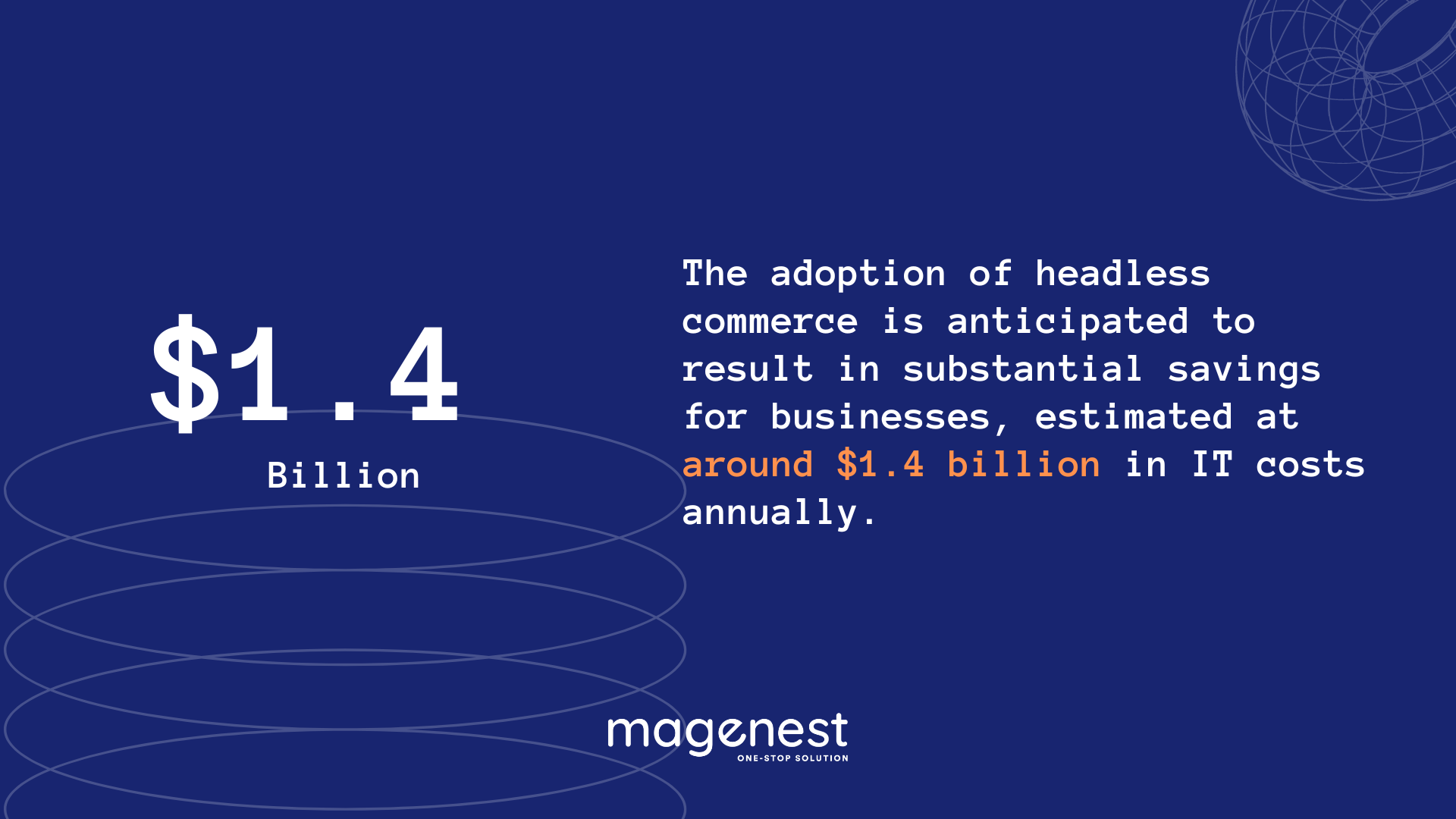
This remarkable figure underscores the significant financial benefits that headless commerce brings to the table. It’s not just about cutting costs; it’s about strategically reallocating resources to foster growth and innovation. This substantial saving is a clear indicator of the efficiency and effectiveness that headless commerce introduces to an organization’s IT operations.
The $1.4 billion in annual savings is a testament to the transformative impact of headless commerce. It represents a shift in how businesses approach their digital infrastructure, moving towards a more flexible, scalable, and cost-effective model. This transition to headless commerce isn’t merely a trend; it’s an essential strategy for businesses aiming to optimize their operations and stay competitive in the rapidly evolving digital landscape.
Boosting SEO Success with Headless Commerce: Insights from 38% of Businesses
A noteworthy insight from the world of headless commerce reveals that 38% of businesses using headless technology have seen a significant improvement in their SEO rankings.
This statistic is a crucial highlight in discussions about headless commerce. It presents a strong case for businesses contemplating headless commerce as a strategic approach for their online platforms. The improvement in SEO ranking not only offers a potential edge in search engine visibility but also demonstrates the tangible benefits realized by businesses that have adopted this cutting-edge technology.
This data point serves as a beacon for companies looking to enhance their digital strategy, illustrating how headless commerce can be a game-changer in optimizing search engines and improving overall online visibility.
Dramatic Conversion Rate Boost with Headless Commerce
In the innovative sphere of headless commerce, a striking statistic emerges: businesses that adopt this approach experience an impressive 42% average increase in conversion rates. This significant number is a clear indicator of the transformative impact headless commerce can have on a business’s online performance.
This surge in conversion rates underscores the effectiveness of headless commerce in enhancing customer experiences and streamlining eCommerce operations. It highlights the powerful capability of this technology to not only attract but also retain customer engagement more effectively, leading to increased sales and business growth.
This 42% increase in conversions is a compelling reason for businesses to consider switching to a headless commerce platform, showcasing the profound benefits of embracing this modern eCommerce strategy.
Future of Headless Commerce Adoption Trend
The future of headless commerce adoption paints a promising and transformative picture for the world of digital commerce. Leveraging insights from the current trends and headless commerce statistics, it’s evident that headless commerce is not just a fleeting phenomenon but a strategic pivot that’s reshaping the eCommerce landscape. And if you want to have a comprehensive view of the landscape of the eCommerce world in 2023, don’t forget to check our eCommerce statistics 2023 article.
Increased Adoption Across Industries
As businesses continue to recognize the agility, efficiency, and customer experience enhancement that headless commerce offers, its adoption is expected to skyrocket. Currently embraced primarily by B2B and retail sectors, headless commerce is likely to see broader adoption across various industries. The flexibility to tailor customer experiences and integrate with emerging technologies makes headless commerce a sought-after solution for businesses aiming to stay at the forefront of digital innovation.
Focus on Improved Customer Experiences
The driving force behind the headless commerce adoption trend is the unyielding pursuit of superior customer experiences. With headless commerce statistics showing significant improvements in site performance, SEO rankings, and conversion rates, more businesses are likely to transition to headless commerce platforms. This approach allows for greater personalization and faster response to market changes, which are crucial in meeting the evolving demands of modern consumers.
Strategic Cost Savings and Operational Efficiency
The potential for considerable cost savings in IT and operational efficiencies is another factor fueling the adoption of headless commerce. The reported savings and reductions in time spent on upgrades, bug fixes, and site management indicate a shift towards more resource-efficient eCommerce strategies. Businesses, especially SMEs and startups, will likely continue to leverage headless commerce to optimize their digital strategies while keeping operational costs in check.
Expansion and Innovation in Technology
The future of headless commerce is also intertwined with advancements in related technologies such as AI, machine learning, and IoT. The decoupled nature of headless architecture offers seamless integration with these technologies, enabling businesses to innovate and expand their digital capabilities. This will lead to more sophisticated and interactive online shopping experiences, further driving the adoption of headless commerce.
Growing Market Penetration and Global Reach
With the continuous globalization of eCommerce, headless commerce platforms are set to expand their reach. The ability to easily adapt to different markets and cultural contexts, thanks to their flexible architecture, positions headless commerce as a key player in the global digital economy.
In Conclusion,
As we reflect on the array of compelling headless commerce statistics and trends for 2023, it’s clear that we are witnessing a significant shift in the digital commerce landscape. Headless commerce, once a novel concept, has now cemented its position as a critical component in the toolkit of modern businesses seeking agility, efficiency, and enhanced customer engagement.
The journey through the headless commerce statistics of 2023 reveals a narrative of transformation and growth. Looking ahead, the trajectory of headless commerce adoption suggests a continued rise in its popularity and application across various industries. As businesses strive to meet the ever-changing needs of their customers and stay ahead in the digital race, headless commerce emerges as a beacon of innovation and strategic foresight.
To stay informed with valuable insights and tips for excelling in the dynamic world of eCommerce, be sure to subscribe to our newsletter. We regularly share the latest updates and expert advice to help you navigate and succeed in the eCommerce and Digital Transformation industries.











